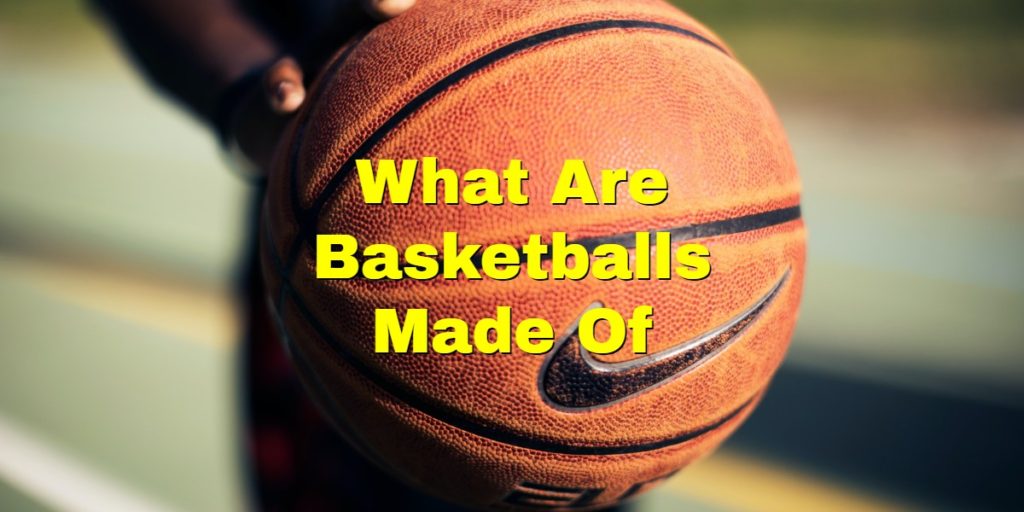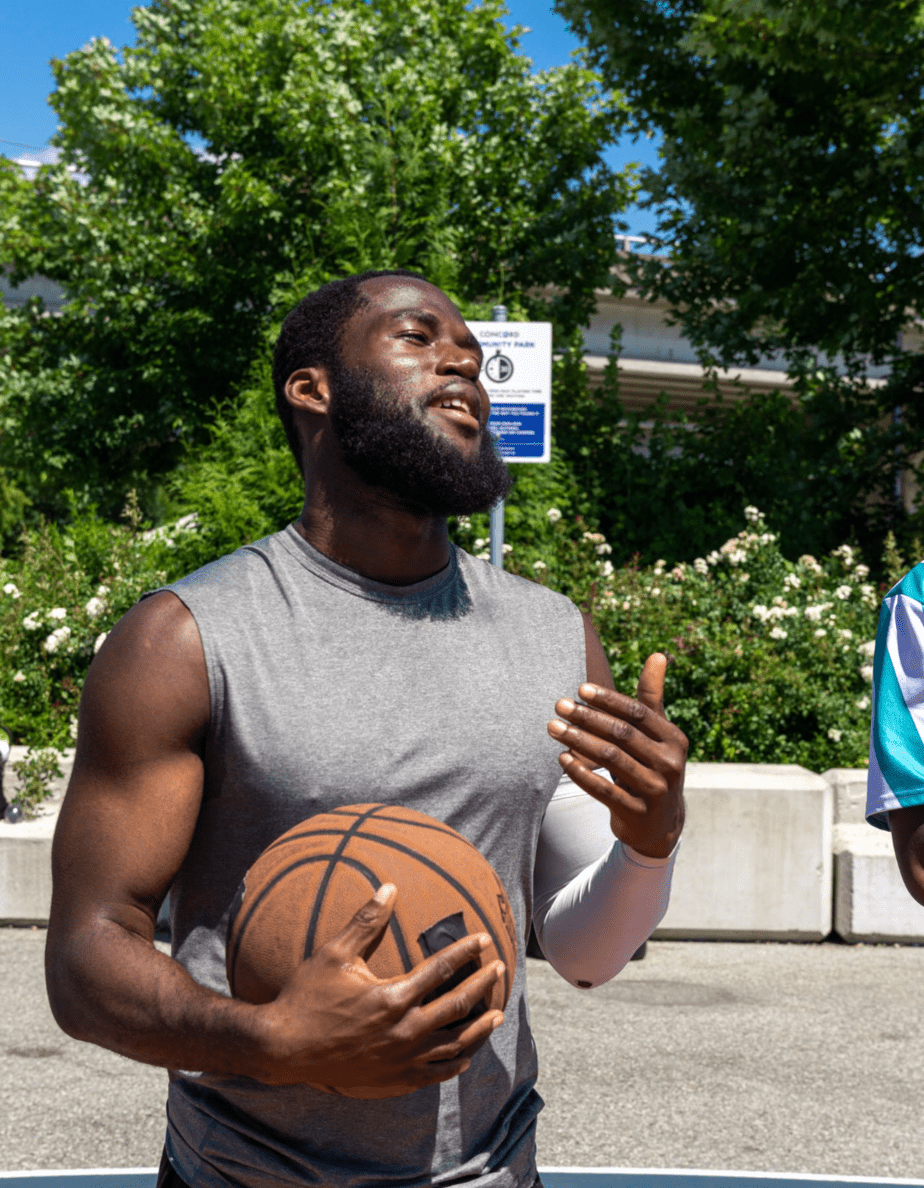What Are Basketballs Made Of: Composite, Synthetic, Rubber and Leather Balls
Have you ever been playing on a basketball court and thought, “What is this basketball made of?” What are the material components of a basketball? How do they work together to create that balance of firmness and bounce? Who came up with this design anyway?
We will start with what basketballs are made of. Typically, basketballs are synthetic, usually made out of durable synthetic rubber.
However, every basketball has three main components that are crucial to its design and efficacy. These three components are:
- The ball cover
- The windings
- The inner bladder
The Ball Cover
The ball cover is the part that you see and touch. This fabric will vary depending on the purpose of the ball. The brown-colored leather we are used to seeing is very effective on indoor surfaces. However, on outdoor surfaces, it will wear down quicker. Generally, outdoor basketballs have a ball cover made of durable rubber or a composite of synthetic materials.
Leather Materials
If you take apart a professional basketball off a court in a game, it will consist of genuine leather materials. Leather is best when playing on wooden indoor courts with ideal conditions—e.g. no weather. Anywhere outside of this environment will call for a different type of material since leather will not hold up against rain, concrete, asphalt, or other rough surfaces.
Rubber, Composite, or Synthetic Materials
Rubber basketballs are relatively inexpensive to produce in mass amounts and are highly durable, making them a more affordable option for many recreational players. Composite materials and synthetic materials can be more expensive to manufacture than rubber, but they are traditionally softer on the hands and easier to manipulate, making them a popular choice.
The Windings
The windings are on the inside of the ball, between the ball cover and the inner bladder. These are often composed of nylon threads or polyester. Windings serve as the binding agent that insulates the inner bladder and adds a layer of protection to help keep the ball in its spherical shape.
The Inner Bladder
The inner bladder is the interior part of the ball that holds the air. When you pump up your basketball with an air pump, the air goes into the inner bladder. This bladder is crafted from a synthetic type of rubber that holds air better than traditional rubber.
Adding air to a basketball is an easy process, especially as pumps can be manual or automatic. They use a small needle at an insertion point in the ball. Once the ball is at your desired inflation circumference, you are ready to play!
The Little Touches
Although it is not necessary to include little touches when making a basketball, many manufacturers add additional items to the outside for a distinctive appearance.
These often include logos or decals made of foil or other materials that will stick easily to the surface. Not only does it differentiate one ball from another model, but they also help advertise brands to sports enthusiasts.
How Are Basketballs Made Video
Fascinating insight into how basketballs are actually made by Wilson.
The History of Basketball Materials
Next, let’s talk about the history of the ball. You might be surprised to learn that an American created basketball back in the 1890s.
A physical education teacher in Massachusetts created the game of basketball for his class as a way for students to enjoy sports in the winter season. At first, they played the game with a soccer ball and peach baskets!
The original basketballs were manufactured at the behest of that very physical education teacher. He commissioned the ball from the owner of Spalding, making Spalding the first company to make balls specifically for the game of basketball.
The earliest basketballs used panels of leather stitched together. On the inside of these leather panels were the rubber bladders. A cloth lining gave more support to the leather and promoted a uniform look across all manufactured basketballs.
A leather covering was the standard up until the 1990s. However, by that time, synthetic substances had emerged as a sturdier material. As a result, you may find cheaper versions of basketballs that have synthetic ball coverings rather than genuine leather.
The NBA only uses balls with ball coverings made from genuine leather. Briefly, in the mid-2000s, a microfiber ball was introduced and tested out in the league. It was supposed to help wick away sweat. Ultimately, it was not well received and was taken out of league play quickly after its introduction.
Interestingly, there are no industry specifications as to how to make a basketball. However, current standards in leagues like the NCAA, NBA, and WNBA specify what type of ball must be used in gameplay to ensure equity.
How Many Basketballs Are Made Each Year?
Basketball is a popular worldwide sport, and because of its loyal following, there is a continuous need for these balls. But, unfortunately, even when consisting of high-quality materials, they do not last forever.
So how many basketballs are made each year to satisfy the demand? Unfortunately, this number can be challenging to narrow down since so many countries have manufacturing processes available.
It is well-known that in the United States, there are over 250,000 basketballs sold each year. We can then assume that there are more than that in circulation to meet consumers’ adequate supply and demand needs.
Statistics from 1998 reveal total basketball sales topping 3.6 million balls in the United States alone. And when you consider other areas around the world outside of the U.S., this number will climb exponentially.
Italy is one of the more popular countries outside of North America that have a loyal basketball following. They have men’s and women’s Olympic basketball teams, and it is a favored pastime for many residents.
Wrapping Up
Much like other sports equipment, the materials, and manufacturing processes have changed over the years. With advancements in technology and fabrication, basketballs have come a long way from pieces of leather panel and cloth stitched together.
Unless you are playing basketball with the pros, your ball is made most likely from rubber or synthetic materials for added durability.

Troy Wright
I am a lifetime basketball enthusiast and loved playing basketball competitively through high school. I still try and play at least 3 times a week and explore all kinds of equipment and training to keep myself on the court and continually getting better. I am a college basketball fanatic and move onto the NBA when March Madness ends.
Meaningful conversations happening daily about training, recovery, and injury-specific rehabilitation as well as sport-specific discussions on playing, coaching and refereeing your favorite sport. We welcome experts and those with curious minds seeking answers.
Join The Stay On The Court Community!